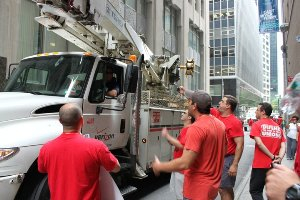Verizon fired 40 union members in December for picket-line activity. Aren’t members protected in legally sanctioned strikes?
Not always. The courts and the NLRB have given employers the ability to discipline workers for “picket line misconduct” or “egregious misconduct.”
They define misconduct as assaults, property destruction, and extensive blocking of non-strikers, including strikebreakers.
To win, unions must affect business as usual. But unions can prevent firings for strike conduct by mounting massive and disciplined activity that doesn’t allow the boss to target a few troublemakers.
Robert Schwartz, in his must-read book, Strikes, Picketing and Inside Campaigns: A Legal Guide for Unions, gives examples of how the NLRB has defined misconduct:
• Warning a line-crosser, “we know where you live and we’re coming to get you”
• Throwing rocks or bottles
• Banging on a scab’s car with a picket sign or spitting on scabs
• Placing nails on the road
The NLRB has extended the concept to include actions or threats that can reasonably be assumed to intimidate or coerce non-strikers from crossing the picket line.
While yelling at scabs and calling them scabs is allowed, coupling that with racial or sexual epithets can get a striker fired.
EDUCATE MEMBERS
Make sure that strikers understand the problem with individually threatening a scab. While it feels good to yell, that’s not what wins the strike. Have plenty of chants ready for members to use, and remind them that picket lines are video recorded, so all actions are documented unless a wall of picket signs blocks the camera.
When the strike is effectively disrupting business, there is no need for many of the other actions. They become counterproductive.
If employers restart production with strikebreakers, action must be taken that may violate the law, such as mass picketing. The steward’s job is to make sure it is a mass activity and that it is disciplined.
That way, any repercussions will be directed at the union, not at a few individuals. The involvement of supporters who aren’t part of the union becomes extremely important at this point.
Fifteen weeks into a strike at one small Massachusetts factory, the company advertised to hire strikebreakers. The union mobilized, and hundreds of members from other workplaces and students from a nearby university converged on the picket line. Needless to say it was a wild event.
This continued for several days until the company got an injunction limiting the union to four picketers at the gate. The mass picketing continued—it just moved onto both sides of the road approaching the factory. Picket lines swelled to 500, stopping traffic.
The union was threatened with fines, but claimed it had obeyed the injunction by limiting the pickets at the gate to just four.
After several days the police ordered the factory shut down to restore order. At that point negotiations resumed and a settlement was reached.
DOCUMENT
The union must document threats, name-calling, or aggressive driving by non-strikers. These can be used to show disparate treatment if the employer tries to fire strikers but does not discipline non-strikers for similar conduct.
Keep a log with time, date, names, and exact description of the event.
Most important, the union should include a “no discipline for picket line misconduct” clause in the strike settlement. This will prevent the company from firing people upon their return to work. This, of course, is easier to negotiate if the union settles from a position of strength.
If the union isn’t able to get a “no discipline” clause, or the firings take place before the settlement, then the union must grieve and aggressively follow up with information requests. The union needs to show that the employee’s actions were not egregious or that the employer is engaging in disparate treatment by singling out some workers.
The union can also pursue a charge with the NLRB, saying the discipline results from legally protected union activity.
MOON OVER MIAMI
Sometimes the union has problems when a member insists on getting into trouble. On one picket line, a member drank heavily despite warnings that this was not allowed. He then mooned the office secretaries, who were not in the union, and was arrested several times for the moonings.
During strike settlement negotiations, the company said it would fire the mooner. The hard fact was that most members didn’t want to defend him, because they felt his problems were of his own making. But the union was able to get him reinstated with a suspension.
In similar situations, unions may have to agree to a general “no reprisals” clause but agree that certain cases head to arbitration.
Strikes are tough these days, but we can win by being militant, disciplined, and prepared to protect the picketers in the inevitable settlement.
David Cohen is a retired international rep for the United Electrical Workers.






